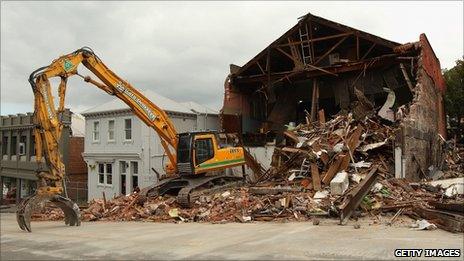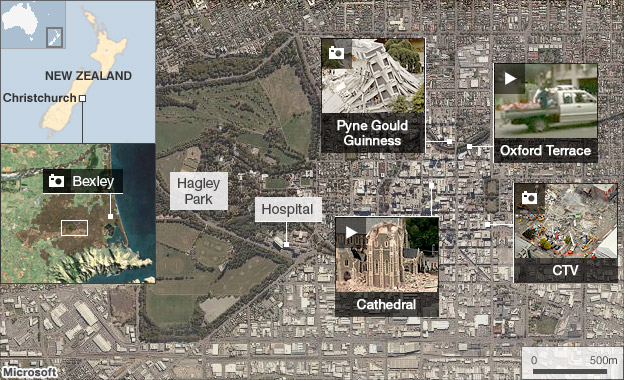Third of Christchurch buildings 'could face demolition'
- Published

Rescuers say they are losing hope of finding the scores of people still missing
A third of the buildings in central Christchurch may need to be demolished and rebuilt, authorities in New Zealand have warned, following an earthquake.
Hundreds of suburban homes damaged in Tuesday's 6.3 magnitude tremor may also have to be pulled down, officials said.
Prime Minister John Key said the country may be facing its biggest ever tragedy, as the death toll rose to 144.
Rescue efforts are entering a fifth night, but only bodies are being found.
Hopes that the 200 people still missing will be found alive are fading, officials say. No survivors have been found in the rubble of Christchurch for more than 72 hours.
Mr Key said the disaster "may be New Zealand's single most tragic event", outstripping a 1931 quake which killed 256.
The prime minister has met relatives of the dead and missing, and announced that a two-minute silence would be held on Tuesday at 1251 local time (2351 GMT Monday), a week after the quake struck.
He said friends and relatives of those unaccounted for were fearing the worst because "a significant period of time has elapsed".
"I think it's fair to say they fear the worst but there is still a glimmer of hope," he said.
Identifying the dead
Auckland University structural engineer Jason Ingham told TVNZ said many damaged buildings in the city centre will have to come down.
"We've collected some data over the past couple of days and it's looking like about one-third of the buildings (would be condemned)," Mr Ingham told TVNZ.
The BBC's Phil Mercer says rescuers from 10 countries, including Britain, Japan and the United States, have been searching broken buildings and piles of debris, as aftershocks continue.
Emergency worker Phil Parker said teams of eight to 12 people were still going into buildings, but said the work was tough and unpredictable.
The BBC's Rachel Harvey explains how rescuers mark buildings they search
"Obviously we're getting aftershocks so we've got to be prepared for those," he told the BBC.
"We won't be going into buildings that are deemed unsafe, that's why we're checking them now, but there's always that danger of the buildings coming down on us."
Meanwhile, families of the missing have appealed for the identification process to be accelerated, but officials have asked for patience.
A police spokesman, Dave Cliff, said identifying the dead and updating the lists of those missing was a "slow and methodical process".
"We are going through it as fast as we possibly can in order to get the deceased reunited with their loved ones," he said at a news conference in Christchurch.
"The number of missing people that we have reported for which we have grave concerns, remains at more than 200 and we are progressively going through that list doing all we can to locate and validate the fact that those individuals reported missing by their families remain missing."
'Shattering blow'
Earlier, Christchurch mayor Bob Parker praised the progress made by emergency workers.
"The structure of the city has received a shattering blow, but we're making incredible progress," Mr Parker told BBC World News on Saturday.
Mr Parker said energy supplies around the city were running at around 50% capacity, and that the rest of the city would be connected within days.
For many residents, it is all too much, and there is an exodus from Christchurch, our correspondent says.
Officials believe up to 22 bodies may lie beneath the rubble of Christchurch Cathedral; as many as 120 are thought to have been killed inside the collapsed CTV office block, including Japanese, Chinese and Philippine nationals; many others are presumed dead inside the destroyed Pyne Gould Guinness building.
Relatives of missing foreign nationals have also been arriving from overseas.
Power has been restored to most of the city but water supply remains a problem, with residents being urged to boil water for drinking or cooking due to contamination fears.
The quake struck at a shallow depth of 5km (3.1 miles) early on Tuesday afternoon, when the South Island city was at its busiest.
CLICKABLE Select the images for more details.

Bexley

Streets in the north-eastern suburb of Bexley were flooded as the quake caused water mains to burst, which coincided with heavy rain.
Pyne Gould Guinness

The multi-storey Pyne Gould Guinness Building, which normally houses around 200 workers, collapsed. A number of people were thought to be trapped inside.
Cathedral

The 63m spire of the city's Anglican cathedral was toppled by the earthquake. A New Zealand TV reporter took a look inside the damaged building.
CTV building

Part of Christchurch's Canterbury Television [CTV] building completely collapsed in the earthquake. Some 24 people have been rescued from the building, but police said there might be between 60 and 120 bodies trapped underneath.
Oxford Terrace

In the aftermath of the earthquake, Rhys Taylor took this video on Oxford Terrace, 50 metres away from the city's main hospital. He said: "Cars were being used as ambulances to transport the injured."
- Published25 February 2011
- Published24 February 2011
- Published23 February 2011
- Published23 February 2011